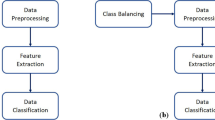Abstract
This paper proposes a scheme consisting of two novel components to recognize multiple hand motions from surface electromyography (SEMG). First, we use the cumulative residual entropy (CREn), a measure of uncertainty in a random variable, as the feature. Second, we employ the extreme learning machine (ELM), a fast and effective classifier using single-hidden layer feedforward neural network with additive neurons, to distinguish different motions. To evaluate performance of the proposed system, we compare CREn with fuzzy entropy, sample entropy, and approximate entropy, and a state-of-the-art time-domain feature; and ELM with linear discriminant analysis and support vector machine. They are tested on four channel SEMG signals acquired from ten normal subjects. Experimental results indicate that the classification accuracies of CREn are not only better than those of other entropies with all the classifiers, but also comparable to the time-domain feature for all the segment lengths of 200, 250 and 1,000 ms with all classifiers that are evaluated. Furthermore, the computational complexity of CREn is lower than those of other features, and ELM performs significantly faster than other classifiers without sacrificing any performance. It suggests that the proposed CREn-ELM scheme has the potential to be applied to real-time control of SEMG-based multifunctional prosthesis.




Similar content being viewed by others
Abbreviations
- SEMG:
-
Surface electromyography
- AEn:
-
Approximate entropy
- SEn:
-
Sample entropy
- FEn:
-
Fuzzy entropy
- CREn:
-
Cumulative residual entropy
- LDA:
-
Linear discriminant analysis
- SVM:
-
Support vector machine
- ELM:
-
Extreme learning machine
- SLFNN:
-
Single-hidden layer feedforward neural network
- TD:
-
Time domain
References
Oskoei MA, Hu HS (2007) Myoelectric control systems—a survey. Biomed Signal Process Control 2:275–294
Chen WT, Wang ZZ, Xie HB, Yu WX (2007) Characterization of surface EMG signal based on fuzzy entropy. IEEE Trans Neural Syst Reh EN 15:266–272
Zecca M, Micera S, Carrozza MC, Dario P (2002) Control of multifunctional prosthetic hands by processing the electromyographic signal. Crit Rev Biomed Eng 30:459–485
Lei M, Wang ZZ, Feng ZJ (2001) Detection nonlinearity of action surface EMG signal. Phys Lett A 290:297–303
Swie YW, Sakamoto K, Shimizu Y (2005) Chaotic analysis of electromyography signal at low back and lower limb muscles during forward bending posture. Electromyogr Clin Neurophysiol 45:329–342
Berthold B (2006) Entropy. Best Pract Res Clin Anesthesiol 20:101–109
Katsev S, Heureux IL (2003) Are Hurst exponents estimated from short or irregular time series meaningful? Comput Geosci 29:1085–1089
Pincus SM (1991) Approximate entropy as a measure of system complexity. Proc Nat Acad Sci USA 88:2297–2301
Pincus SM (1995) Approximate entropy (ApEn) as a complexity measure. Chaos 5:110–117
Manis G (2008) Fast computation of approximate entropy. Comput Method Program Biomed 91:48–54
Ahmad SA, Chappell PH (2008) Moving approximate entropy applied to surface electromyographic signals. Biomed Signal Process Control 3:88–93
Kosmidou VE, Hadjileontiadis LI (2010) Using sample entropy for automated sign language recognition on sEMG and accelerometer data. Medical Biolog Eng Comput 48:255–267
Chen WT, Zhuang J, Yu WX, Wang ZZ (2009) Measuring complexity using FuzzyEn, ApEn, and SampEn. Med Eng Phys 31:61–68
Xie HB, Guo JY, Zheng YP (2010) Fuzzy approximate entropy analysis of chaotic and natural complex systems detecting muscle fatigue using electromyography signals. Ann Biomed Eng 38:1483–1496
Istenic RR, Kaplanis PA, Pattichis CS, Zazula D (2010) Multiscale entropy-based approach to automated surface EMG classification of neuromuscular disorders. Med Biol Eng Comput 48:773–781
Almanji A, Chang JY (2006) Feature extraction of surface electromyography signals with continuous wavelet entropy transform. Microsyst Technol 2:1–10
Chen WT, Wang ZZ, Ren XM (2006) Characterization of surface EMG signals using improved approximate entropy. J Zhejiang Univ Sci B 7:844–848
Rao ML, Chen YM, Vemuri BC, Wang F (2004) Cumulative residual entropy: a new measure of information. IEEE Trans Inform Theory 50:1220–1228
Wang F, Vemuri BC (2007) Non-rigid multi-modal image registration using cross-cumulative residual entropy. Int J Comput Vision 74:201–215
Wang F, Vemuria BC, Eisenschenk SJ (2006) Joint registration and segmentation of neuroanatomic structures from brain MRI. Acad Radiol 13:1104–1111
Englehart K, Hudgins B, Parker PA (2001) A wavelet-based continuous classification scheme for multifunction myoelectric control. IEEE Trans Biomed Eng 48:302–310
Bu N, Okamoto M, Tsuji T (2009) A hybrid motion classification approach for EMG-based human–robot interfaces using bayesian and neural networks. IEEE Trans Robot 25:502–511
Oskoei MA, Hu H (2008) Support vector machine-based classification scheme for myoelectric control applied to upper limb. IEEE Trans Biomed Eng 55:1956–1965
Huang GB, Zhu QY, Siew CK (2006) Extreme learning machine: theory and applications. Neurocomputing 70:489–501
Hudgins B, Parker P, Scott RN (1993) A new strategy for multifunction myoelectric control. IEEE Trans Biomed Eng 40:82–94
Richman JS, Moorman JR (2000) Physiological time-series analysis using approximate and sample entropy. Am J Physiol Heart Circ Physiol 278:2039–2049
Belhumeur PN, Hespanha JP, Kriegman DJ (1997) Eigenfaces vs. fisherfaces: recognition using class specific linear projection. IEEE Trans Patt Anal Mach Intell 19:711–720
Hsu CW, Lin CJ (2002) A comparison of methods for multi-class support vector machines. IEEE Trans Neural Netw 13:415–425
Kiatpanichagij KP, Afzulpurkar NT (2009) Use of supervised discretization with PCA in wavelet packet transformation-based surface electromyogram classification. Biomed Signal Process Control 4:127–138
Smith LH, Hargrove LJ, Lock BA, Kuiken TA (2011) Determing the optimal window length for pattern recognition-based myoelectric control: balancing the competing effects of classification error and controller delay. IEEE Trans Neural Syst Rehabil Eng 19:186–192
Venables WN, Ripley BD (2002) Modern applied statistics with S, 4th edn. Springer, USA
Acknowledgments
This work was supported in part by the Natural Science Foundation of China (60701021), and Leading Academic Discipline Project of Shanghai Educational Committee (J50104). The authors would like to thank Professor Shuozhong Wang for his assistance in improving the language usage.
Author information
Authors and Affiliations
Corresponding author
Rights and permissions
About this article
Cite this article
Shi, J., Cai, Y., Zhu, J. et al. SEMG-based hand motion recognition using cumulative residual entropy and extreme learning machine. Med Biol Eng Comput 51, 417–427 (2013). https://doi.org/10.1007/s11517-012-1010-9
Received:
Accepted:
Published:
Issue Date:
DOI: https://doi.org/10.1007/s11517-012-1010-9




